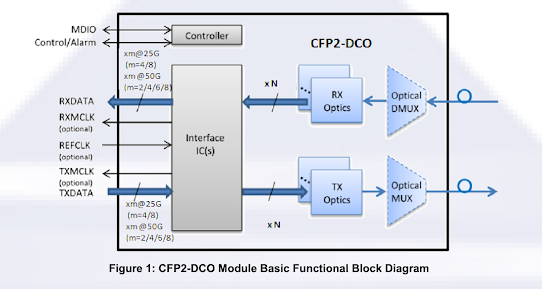EDFA Optical Amplifier - Detailed reference
As an integrated part of long haul data transmission, an optical amplifier is able to amplify optical signals directly without the need to convert the signal into an electrical one before amplifying, which is also the most prominent feature. Among the many different optical amplifiers that can achieve amplification over long-haul optical communication, Erbium-doped fiber amplifier (EDFA) is one of the most commonly used types.
EDFA Optical Amplifier—Boosting Optical Signals More Effectively
When being transmitted over long distances, the optical signal has to be amplified many times in between owing to the signal loss from fiber attenuation, connectivity losses, fiber splicing losses, etc. Before an optical amplifier is invented, the optical signal has to be first converted into an electrical signal, amplified, and then converted back to an optical signal again. The process is very complicated and expensive. To overcome such a problem, the optical amplifier has since been invented to amplify signals directly so that this process is significantly cheaper and started a fiber optic revolution.
There are several types of fiber optic amplifiers: semiconductor optical amplifier(SOA), fiber Raman and Brillouin amplifier, and erbium-doped fiber amplifier (EDFA). Among these optical amplifier types, EDFA is the most widely deployed one in the WDM system. It uses the erbium-doped fiber as an optical amplification medium to directly enhance the signals. Nowadays, EDFA is commonly used to compensate for fiber loss in long-haul optical communication. The most important characteristic is that it can amplify multiple optical signals simultaneously and easily combined with WDM technology. Generally, it is used in the C band and L band, nearly in the range from 1530 to 1565 nm. But it also should be noticed that EDFAs cannot amplify wavelengths shorter than 1525 nm.

How Does an EDFA Work?
The basic structure of an EDFA consists of a length of Erbium-doped fiber (EDF), a pump laser, and a WDM combiner. The WDM combiner is for combining the signal and pump wavelength so that they can propagate simultaneously through the EDF. The lower picture shows a more detailed schematic diagram of EDFA.

The optical signal, such as a 1550nm signal, enters an EDFA amplifier from the input. The 1550nm signal is combined with a 980nm pump laser with a WDM device. The signal and the pump laser pass through a length of fiber doped with Erbium ions. As we talked above, EDFA uses the erbium-doped fiber as an optical amplification medium. The 1550nm signal is amplified through interaction with the doping Erbium ions. This action amplifies a weak optical signal to a higher power, effecting a boost in the signal strength.
Three EDFA Amplifier Types for DWDM Connectivity

Booster Amplifier
A booster amplifier operates at the transmission side of the link, designed to amplify the signal channels exiting the transmitter to the level required for launching into the fiber link. It’s not always required in single-channel links but is an essential part in the DWDM link where the multiplexer attenuates the signal channels. It has high input power, high output power and medium optical gain. The common types are 20dBm Output C-band 40 Channels 26dB Gain Booster EDFA, 16dBm Output C-band 40 Channels 14dB Gain Booster EDFA and so on.
In-line Amplifier
An in-line amplifier is generally set at intermediate points along the transmission link in a DWDM link to overcome fiber transmission and other distribution losses. The in-line EDFA is designed for optical amplification between two network nodes on the main optical link. In-line EDFAs are placed every 80-100 km to ensure that the optical signal level remains above the noise floor. It features medium to low input power, high output power, high optical gain, and a low noise figure.
Pre-amplifier
A pre-amplifier EDFA operates at the receiving end of a DWDM link. The pre-amplifier is used to compensate for losses in a demultiplexer near the optical receiver. Placed before the receiver end of the DWDM link, pre-amplifier EDFA works to enhance the signal level before the photo detection takes place in an ultra-long haul system, hence improving the receive sensitivity. It has relatively low input power, medium output power and medium gain.
Advantages and Drawbacks of EDFA
Nowadays, EDFA optical amplifier rises as a preferable option for signal amplification method for DWDM systems, owing to its low-noise and insensitive to signal polarization. If you are troubled in whether to choose the amplifier, the advantages and disadvantages will give you clues.
Advantages
-
EDFA has high pump power utilization (>50%).
-
EDFA directly and simultaneously amplifies a wide wavelength band (>80nm) in the 1550nm region, with a relatively flat gain.
-
Flatness can be improved by gain-flattening optical filters.
-
Gain in excess of 50 dB.
-
EDFA features low noise figure suitable for long haul applications.
-
EDFA deployment is relatively easier to realize and more affordable compared with other signal amplification methods.
Drawbacks
-
The size of EDFA amplifier is not small.
-
Unlike SOA and Ramen amplifier, EDFA, with a typical size of ten meters long, is difficult to integrate with other semiconductor devices.
-
Since dropping channels can give rise to errors in surviving channels, dynamic control of amplifiers is necessary.
Summary
As EDFA performs as the most widely used optical amplifier, EDFA technology proves to be the most advanced one that holds the dominant position in the market. With the deployment of WDM systems and the increasing aggregate bandwidth of optical fibers, WDM system integrated with EDFA will gain more benefits.
Source of reference:
https://community.fs.com/blog/erbium-doped-fiber-amplifier-edfa.html


Comments
Post a Comment